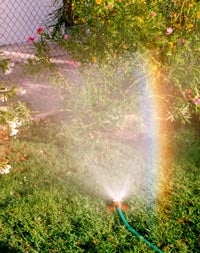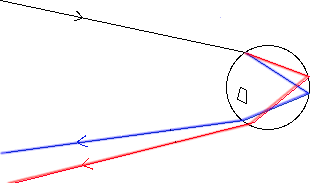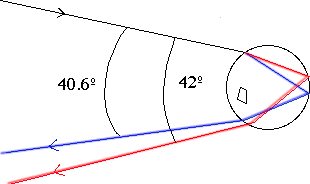

The Pot of Gold
Think back for a moment to the last time you saw a rainbow. Where were you standing relative to the sun? Were you looking toward the sun, or away from it? When you did the activity with the flashlight, the flask of water, and the posterboard, where did you see the spectrum? How does this relate to the position of the sun when you see a rainbow?As you stood looking at the rainbow, the sun was probably above and behind you. The rain was probably somewhere in front of you, if not landing on you at the time! Since the sun was behind and the rain in front of you, the sunlight must have been bouncing off the raindrops and reflecting into your eyes.
If the sunlight is primarily white light and is reflecting off the raindrops, why do we see colors in a rainbow? The colors are present because the sunlight is not only reflecting off the raindrops, it is also refracting and dispersing in the raindrops.

Notice in the drawing how the raindrop acts like a prism, splitting the white light from the sun (in the upper left) into its component colors. For simplification, I have only shown the red and blue beams.
But notice also how the raindrop acts like a mirror in that it reflects (some of) the refracted light back toward the sun. These refracted rays are the ones that you see as a rainbow.
When the white light from the sun hits the raindrop, the light is dispersed as it enters the raindrop, much like light is split as it passes through a prism. The separate colors are then reflected from the backside of the raindrop and exit, where they refract once again, due to the change of index of refraction between the water and the air.
The angles at which each color emerges is different (or else you wouldn't see different colors!): red light emerges at 42° and blue light emerges at 40.6° relative to the incoming ray of sunlight.

Each raindrop contributes only one color to the raindbow that you see.
...but we saw in the rainbow activity that one raindrop can show the whole spectrum! How can a raindrop contribute only one color to the real rainbow?
Go on to the Third Part of the Rainbow
Readings to find out.
Page authored by the ACEPT
W3 Group
Department of Physics and
Astronomy, Arizona State University,
Tempe, AZ 85287-1504
Copyright © 1995-2000 Arizona Board of Regents. All rights reserved.